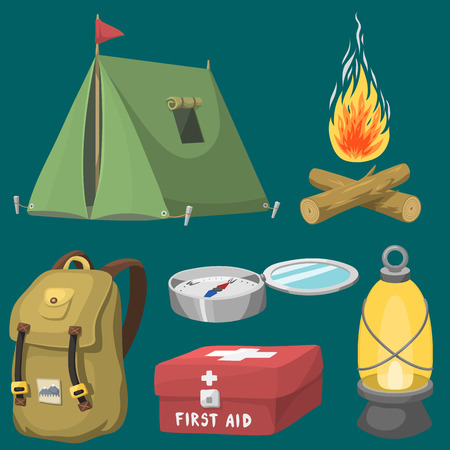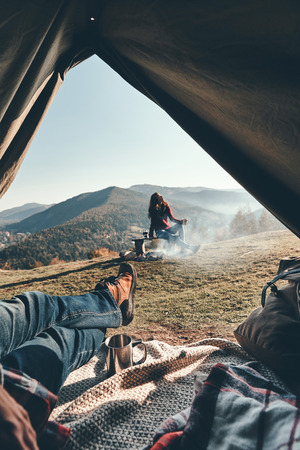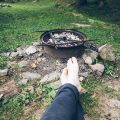1. Choosing the Right Shelter
When youre just getting started with camping, your shelter is one of the most important pieces of gear youll need. A good tent can make or break your outdoor experience, especially if youre not used to sleeping outside. Lets break down what beginner campers should look for when choosing a tent, including size, weather resistance, ease of setup, and some popular brands you’ll find in the U.S.
Types of Tents for Beginners
There are several types of tents that work well for beginners. Here’s a quick overview:
| Type of Tent | Description | Best For |
|---|---|---|
| Dome Tent | Easy to set up, lightweight, and stable. | General camping trips, 1-4 people. |
| Cabin Tent | Taller ceilings and more space, great for families. | Family camping or car camping. |
| Pop-Up Tent | Instant setup; just unfold and it pops into shape. | Short weekend trips or solo campers. |
| Tunnel Tent | Great ventilation and space but needs more anchoring. | Larger groups or longer trips. |
Tent Size Guide
Tent sizes are usually listed by the number of people they can sleep, but its smart to size up. For example, a “4-person” tent is often more comfortable for two adults and their gear.
| # of Campers | Tent Size Suggested |
|---|---|
| 1-2 people | 2-3 person tent |
| 2-4 people | 4-6 person tent |
| 4+ people / family | 6-8+ person tent (Cabin style recommended) |
Weather Resistance Matters
You never know when it might rain or get windy out there. Look for these features:
- Rainfly: A separate cover that protects against rain—essential!
- Taped seams: Prevents leaks where fabric is stitched together.
- Good ventilation: Reduces condensation inside your tent at night.
- Pole strength: Aluminum poles tend to be stronger than fiberglass.
Ease of Setup
If youre new to camping, choose something that doesnt require an engineering degree to pitch. Tents with color-coded poles or pop-up designs are perfect for beginners. Practice setting it up at home before heading out—itll save you time and stress at the campsite.
Popular Beginner-Friendly Brands in the U.S.
The U.S. market has plenty of trusted brands known for quality and ease-of-use. Heres a shortlist you can count on:
- Coleman: Budget-friendly and widely available at Walmart or Amazon.
- Kelty: Known for quality entry-level gear with simple designs.
- Marmot: A bit pricier but offers excellent weather protection.
- The North Face: Durable tents designed for various conditions.
- REI Co-op: Great customer service and helpful advice in stores or online.
Your shelter is your home away from home while camping. Picking the right one ensures you stay dry, comfortable, and ready to enjoy your outdoor adventure. Choose wisely based on your group size, trip type, and how much effort you want to put into setup—and you’ll be off to a great start!
2. Sleeping Essentials for a Good Night’s Rest
Getting a good nights sleep is one of the most important parts of enjoying your camping trip. When youre well-rested, youre more energized and ready to take on the days adventures. To sleep comfortably outdoors, youll need to build a sleeping system that suits your needs and matches the climate where youll be camping. Here are the key components every beginner camper should include in their gear kit:
Sleeping Bags
Choosing the right sleeping bag depends on where and when youre camping. In the U.S., temperatures can vary widely depending on the region and season. Heres what to consider:
| Type | Best For | Temperature Rating | Notes |
|---|---|---|---|
| Summer Bag | Southeast, Southwest (warm nights) | 40°F and above | Lightweight and breathable |
| 3-Season Bag | Northeast, Midwest, Pacific Northwest | 20°F to 40°F | Most versatile for beginners |
| Winter Bag | Mountain regions, winter camping | Below 20°F | Bulky but warm—only needed for cold trips |
Pro Tip: Choose a mummy-style bag for extra warmth or a rectangular bag for more space if you tend to move around while sleeping.
Sleeping Pads
A sleeping pad not only adds comfort but also provides insulation from the cold ground. Even in summer, ground temperatures can sap your body heat overnight.
Main Types of Sleeping Pads:
- Foam Pads: Budget-friendly and durable, but bulky. Great for car camping.
- Self-Inflating Pads: Easy to use with decent comfort and insulation. Good middle-ground option.
- Air Pads: Lightweight and compact, ideal for backpacking. Some models come with built-in insulation.
Pro Tip: Check the R-value (insulation rating) of the pad. An R-value of 2–4 is good for spring through fall; higher than 5 is best for colder temps.
Camp Pillows
You could roll up a hoodie as a pillow, but having an actual camp pillow can improve your sleep significantly. Look for options that are lightweight, compressible, and easy to clean.
Pillow Options:
- Inflatable Pillows: Very compact, adjustable firmness.
- Compressible Pillows: More like home pillows; softer but bulkier.
- Pillow Stuff Sacks: Doubles as a stuff sack during the day and converts into a pillow using clothes or soft gear at night.
Pro Tip: If you’re car camping or have extra room, don’t hesitate to bring your favorite pillow from home!
A solid sleep setup will make a huge difference in how much you enjoy your time outdoors. Start simple and upgrade over time as you figure out what works best for your body and camping style.

3. Camp Cooking Basics
Cooking at a campsite doesnt have to be complicated. With the right beginner-friendly gear and a few easy meal ideas, you can enjoy delicious food while soaking up the great outdoors. Heres what you need to know to get started with camp cooking.
Essential Cooking Gear for Beginners
Start with the basics—gear that is easy to use, portable, and perfect for simple meals. Heres a quick overview of what youll need:
| Item | Description | Beginner Tip |
|---|---|---|
| Portable Stove | Compact and lightweight stoves powered by propane or butane are ideal for beginners. | Choose a one-burner stove for solo trips or two-burner for family outings. |
| Fuel Canisters | Most camp stoves use small propane or butane fuel canisters that are easy to attach and replace. | Always bring an extra canister just in case—you don’t want to run out mid-meal! |
| Cookware Set | A basic set with a pot, pan, and kettle made from aluminum or stainless steel works well. | Look for nesting sets that save space in your pack. |
| Utensils | Packs usually include spatulas, tongs, knives, and serving spoons made from heat-resistant materials. | You can also bring some items from your kitchen if youre car camping. |
| Cooler | Keeps perishable foods fresh. Choose one with good insulation if you plan on longer trips. | Pre-chill your cooler with ice packs before packing it up. |
Simple and Classic American Camp Meals
You don’t need to be a gourmet chef to enjoy tasty meals outdoors. Here are a few beginner-friendly ideas that require minimal ingredients and effort:
Burgers and Hot Dogs
A classic American favorite. Bring pre-formed patties or hot dogs, buns, and your favorite condiments. Cook them on your camp stove or over the fire using a grill grate or roasting sticks.
Smores
No camping trip is complete without s’mores! Just grab graham crackers, marshmallows, and chocolate bars. Toast the marshmallows over the fire and sandwich them between the crackers and chocolate for a sweet treat.
Foil Packet Meals (Hobo Packs)
Layer sliced potatoes, veggies, and protein (like sausage or chicken) in heavy-duty aluminum foil. Add seasoning, seal the packet, and cook over hot coals or on your camp stove. It’s an all-in-one meal with zero clean-up!
Canned Chili or Soup
If you’re short on time or energy, canned chili or soup heated on your stove makes a satisfying and warm meal. Don’t forget a can opener!
Pro Tips:
- Prep ingredients at home (like chopping veggies) to save time at camp.
- Pack seasonings like salt, pepper, garlic powder, and olive oil in small containers.
- Bring biodegradable soap and a sponge for easy cleanup.
The key to enjoying camp cooking is keeping things simple and planning ahead. With this basic gear and a few go-to recipes, youll be whipping up great meals in no time—even under the stars!
4. Lighting and Power Must-Haves
When the sun sets at your campsite, having the right lighting and power gear can make all the difference between a cozy evening and a frustrating one. Whether youre cooking dinner, reading in your tent, or heading out for a nighttime bathroom trip, here are the essentials to keep your site well-lit and your devices charged.
Essential Lighting Options
There are a few key types of camping lights every beginner should consider packing:
| Lighting Type | Description | Best For |
|---|---|---|
| Headlamps | Lightweight and hands-free; worn on your head | Walking around camp, setting up tents at night, nighttime hikes |
| L.E.D. Lanterns | Bright, wide-area light source; battery or rechargeable powered | Lighting up picnic tables, inside tents, or general area lighting |
| Flashlights | Handheld beam of light with focused direction | Spotlighting tasks, checking trails or wooded areas in the dark |
Pro Tip:
A headlamp with a red light mode is great for preserving night vision and not blinding your campmates.
Portable Power Solutions
You’ll want reliable ways to keep your phone, camera, or GPS device charged—especially if youre going off-grid. Here are some beginner-friendly options:
| Power Source | Description | Good To Know |
|---|---|---|
| Portable Power Banks | A compact battery pack that charges USB devices | Look for 10,000mAh or more for multiple phone charges |
| Solar Chargers | Powers up devices using sunlight; eco-friendly option | Inefficient on cloudy days; works best as backup power |
| Campsite Power Stations | Larger units that can power small appliances and multiple devices | A good choice for car camping or extended stays with high power needs |
Packing Tip:
If youre camping in a national park or remote area without electricity, bring extra batteries or fully charge all power banks before you leave home.
5. Safety and First Aid
When youre heading out into the great outdoors, being prepared for unexpected situations is just as important as packing your tent or sleeping bag. Whether youre exploring a popular national park or setting up at a local campground, having the right safety gear can make all the difference.
Basic First Aid Kit
A basic first aid kit is a must-have in any beginner camping gear kit. Accidents happen—blisters from hiking, minor cuts while cooking, or even insect bites are common. Your kit doesnt need to be fancy, but it should include essentials like:
| Item | Purpose |
|---|---|
| Bandages (various sizes) | Covering cuts and scrapes |
| Antiseptic wipes | Cleaning wounds |
| Tweezers | Removing splinters or ticks |
| Pain relievers (like ibuprofen) | Managing headaches or minor pain |
| Allergy medication (like Benadryl) | Treating allergic reactions |
Navigation Tools
Even if youre planning to stay on marked trails, its smart to carry basic navigation tools. Cell phone signal can be spotty in many U.S. national parks and remote campgrounds. Heres what we recommend:
- Map and Compass: Reliable and battery-free, these are essential for finding your way.
- GPS Device: Helpful in unfamiliar terrain, especially when hiking off-trail.
- Whistle: A simple tool that can help rescuers locate you if you get lost.
Bear Safety Items
If youre camping in areas where bears are common—like Yellowstone, Glacier, or parts of the Sierra Nevadas—bear safety is a real concern. Don’t worry; with the right gear and habits, it’s manageable.
| Item | Why You Need It |
|---|---|
| Bear-proof food container (canister or bag) | Keeps your food secure and scent-contained to avoid attracting bears |
| Bear spray | A powerful deterrent in case of a close encounter—make sure you know how to use it! |
| No-scent trash bags | Helps reduce odors that could lure wildlife into your campsite |
Quick Tips for Staying Safe:
- Store all food and scented items away from your tent.
- Never approach or feed wildlife.
- Let someone know your camping location and expected return time.
- Check local park regulations before your trip—they often have specific bear safety rules.
Packing smart safety gear not only helps you deal with emergencies—it also gives you peace of mind so you can enjoy nature to the fullest.
6. Extras That Make a Big Difference
Once you’ve got your basic camping gear ready—like a tent, sleeping bag, and cooking supplies—it’s time to think about those extra items that can really elevate your outdoor experience. These add-ons aren’t absolutely necessary, but they make your trip way more comfortable and convenient, especially if you’re just starting out.
Must-Have Comfort Boosters
When youre spending time in the great outdoors, comfort matters. Here are a few items that can seriously improve your campsite setup:
| Item | Why It’s Useful |
|---|---|
| Camping Chairs | Give you a comfy place to sit around the fire or relax at camp without sitting on the ground. |
| Coolers | Keep food and drinks cold and fresh, which is especially helpful for longer trips or summer camping. |
| Rain Gear | Staying dry is key to staying happy. A good rain jacket or poncho protects you from unexpected showers. |
| Multi-Tools | Compact tools that include knives, screwdrivers, bottle openers, and more—all in one handy gadget. |
Other Handy Extras
Beyond comfort, there are a few other accessories that can make your first camping trip smoother:
- Headlamp or Flashlight: Essential for moving around at night or finding things in your tent after dark.
- Portable Phone Charger: Keep your devices powered up for photos, maps, or emergency calls.
- Campsite Mat: Helps keep dirt out of your tent and gives you a clean space to step onto with bare feet.
- Bungee Cords & Clips: Great for hanging wet clothes or keeping gear organized around camp.
Pro Tip:
If youre not sure what youll need most, consider renting or borrowing gear before buying everything. That way, you can figure out what extras really make a difference for you without spending too much upfront.
The right accessories can turn a basic camping trip into an unforgettable adventure. These little comforts go a long way in helping beginners feel right at home in the wild.


